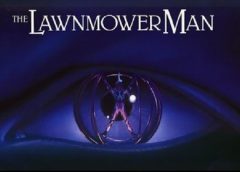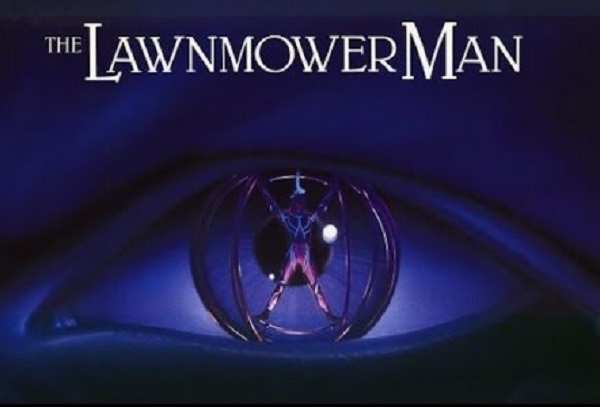
In 1992 the Lawnmower Man movie introduced the concept of virtual reality to a wider audience. It was in part based on the founder of Virtual Reality Jaron Lanier and his early laboratory days. Jaron was played by Pierce Brosnan, a scientist who used virtual reality therapy on a mentally disabled patient. Real virtual reality equipment from VPL research labs was used in the film and the director Brett Leonard, admitted to drawing inspiration from companies like VPL.
Brett Leonard who was the Director of The Lawnmower Man and Virtuosity said “When I made my first little zombie movie called The Dead Pit, which did very well and launched my career, they came to me with this seven-page short story by Stephen King. I said, “Well, I don’t really want to make that movie. I actually want to make a movie about virtual reality.” I couldn’t really make a feature film out of a seven-page short story about a guy being chased by a lawnmower.
I wanted to make something around this computer revolution that I was literally living in the middle of. When I moved from Ohio to Santa Cruz, I was hanging out with people that were hanging out with Wozniak and Jobs. As a young filmmaker, I got a view into that culture, into the thought processes that were going on.
Brett said he actually had to create a video that described what virtual reality was and showed what computer graphic effects were. I mean, the only effects going on at that time were on a 100 million dollar movie. The Lawnmower Man was a $5 million film, and so I had to find a way of putting over 20 minutes of high-end digital effects into a low-budget film. But yet people who weren’t familiar with the technology or computing cybernetics still took it pretty seriously — there was a lot of talk by real scientists about how to prevent these terrible things from happening. It was pretty much an inside joke in the industry. People either liked the movie or not, but no one actually working in the field took it very seriously.
Meanwhile over in Long Beach, California, U.S a baby was born and named ‘Palmer Luckey’ (the Inventor of the Oculus Rift virtual reality headset and co-founder of Oculus VR) oddly, he also remembered watching the movie later on in life: “I love Lawnmower Man. I think it’s awesome. In most fiction about VR, the technology is causing some terrible problem; or it’s caused the end of the world, or used to enslave humanity. But that’s because it wouldn’t be interesting science fiction”
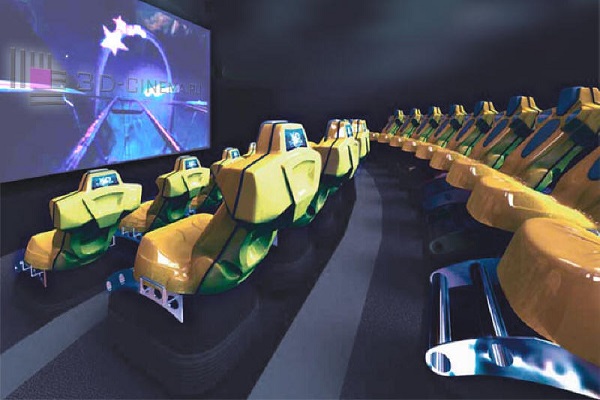
Meanwhile, over in Florida, Disney and Virtual World Entertainment projects were the best-known instances of location-based VR entertainments, other important projects included Iwerks Entertainment’s Turbo Tour and Turboride 3-D motion simulator theatres, first installed in San Francisco in 1992
Another important application of VR at this time was social interaction in virtual worlds. Military simulation and multiplayer networked gaming led the way. Indeed, the first concerted efforts by the military to tap the potential of computer-based war gaming and simulation had taken shape in the mid-1970s. During the 1980s, the increasing expense of traditional (live) exercises focused attention on the resource efficiency of computer-based simulations. The most important networked virtual environment to come out of this era was the DARPA-funded SIMulator NETworking (SIMNET) project, began in 1983 under the direction of Jack Thorpe.
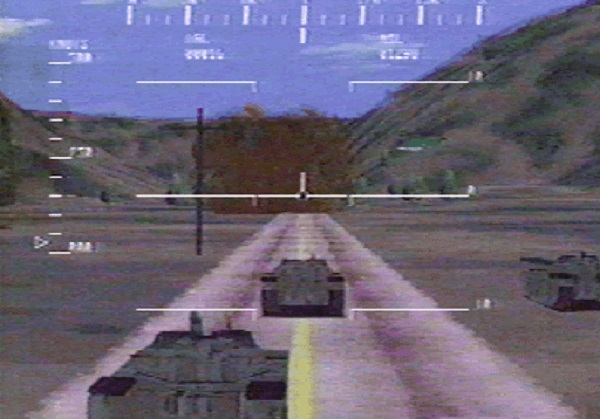
SIMNET was a network of simulators (armoured vehicles and helicopters, initially) that were linked together for collective training. It differed from previous stand-alone simulator systems in two important respects. First, because the training objectives included command and control, the design focused on effect rather than physical fidelity; psychological or operational aspects of battle, for example, required only selective verisimilitude in cabinet design or computer-generated imagery. Second, by linking together simulators, SIMNET created a network not just of physical connections but also of social interactions between players. Aspects of the virtual world emerged from social interactions between participants that had not been explicitly programmed into the computer-generated environment. These interactions between participants were usually of greater relevance to collective training than anything an individual simulator station could provide. In gaming terms, player-versus-player interactions became as important as player-versus-environment interactions and Virtuality’s Dactyl Nightmare make great use of this very same technology.
SIMNET was followed by a series of increasingly sophisticated networked simulations and projects. Important moments included The Battle of 73 Easting (1992), a fully 3-D simulation based on SIMNET of a key armoured battle in the Persian Gulf War called ‘Operation Desert Storm’. This was significant because it was an Armored Cavalry engagement against a force superior in numbers, and because it provided the occasion for the first effort to gather combat data suitable for combat simulation and battle re-creation using advanced technology. While the original data were used as a basis for battle re-creation in SimNet, the authors replicated that effort using the same data and the JanusA Model.
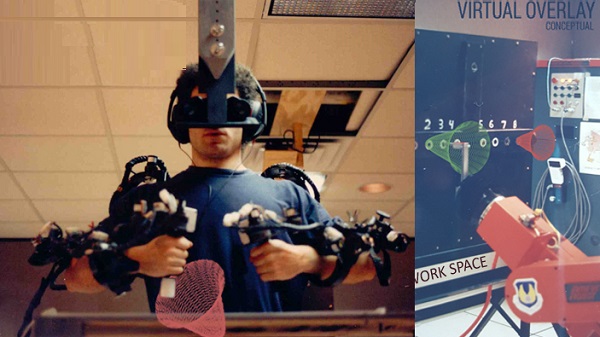
Also in 1992, Louis Rosenberg created the first fully immersive and indeed usable AR system for the U.S Air force Research Laboratory. Because 3D graphics were too slow in the early 1990s to present a photorealistic and spatially-registered augmented reality, Virtual Fixtures used two real physical robots, controlled by a full upper-body exoskeleton worn by the user. To create the immersive experience for the user, a unique optics configuration was employed that involved a pair of binocular magnifiers aligned so that the user’s view of the robot arms were brought forward so as to appear registered in the exact location of the user’s real physical arms.
The result was a spatially-registered immersive experience in which the user moved his or her arms while seeing robot arms in the place where his or her arms should be. The system also employed computer-generated virtual overlays in the form of simulated physical barriers, fields, and guides, designed to assist the user while performing real physical tasks. Fitts LawOffsite Link performance testing was conducted on batteries of human test subjects, demonstrating for the first time, that a significant enhancement in human performance of real-world dexterous tasks could be achieved by providing immersive Augmented Reality overlays to users”
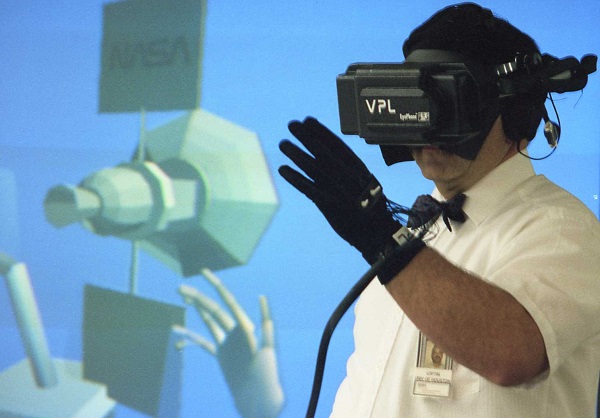
So AR was growing and VR was just reaching peak levels of interest, but not all is well in the world of VR even back here in 1992. VPL Research was one of the first companies that developed and sold virtual reality products. But in 1992 its founder talked of the fall of the company. He said: “The thing to remember about the fall of VPL is that I was gone by then. I left VPL for a lot of reasons — mostly personal — in ’92. VPL fell a year or two after that. If you were to believe what’s in the papers, it’s a pretty exotic thing that happened: the Justice Department uncovered a plot by the French Secret Service to infiltrate it to steal technology. [It] struck me as absurd because there wasn’t much hidden or proprietary. I mean, it wasn’t like there was anything to really steal there. It wasn’t like a death ray or anything, it was really just some code to simulate, like, a gall bladder. The funny thing about the fall of VPL is it turned into this weird movie called The Lawnmower Man. The director had licensed a Stephen King horror thing but then I thought the real VPL story was much more interesting. He turned it into this movie and I was played by Pierce Brosnan, who at that time was an unknown, plus they used real VPL equipment!”.
So it seemed as if 1992 was a bitter-sweet year for VR. On the one hand, it was reaching the public minds (and soon wallets as well) but on the other, the fall of VPL was a sad and bitter blow to the pioneers of the very same technology. It seems to be a thing with virtual reality tech companies to stamp on the people who helped shape it. Sadly the little baby called “Lucky” was unaware that the very same thing was also going to happen to him one day in the very same industry.
But we don’t want to end this chapter on a low point because in 1993 the flood gates of VR opened up and everyone rushed into it. SEGA, Nintendo and even Atari were going to jump into the VR horse race, but not all of them were going to get out of the starting blocks.
